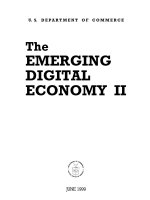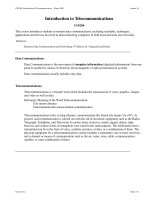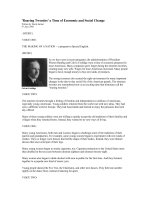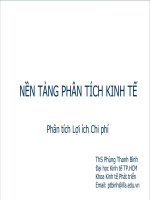Lecture no05 economic equivalence
Bạn đang xem bản rút gọn của tài liệu. Xem và tải ngay bản đầy đủ của tài liệu tại đây (1.45 MB, 12 trang )
Economic Equivalence
Lecture No. 5
Chapter 3
Contemporary Engineering Economics
Copyright © 2016
th
Contemporary Engineering Economics, 6 edition
Park
Copyright © 2016 by Pearson Education, Inc.
All Rights Reserved
Economic Equivalence
What do we mean by “economic equivalence?”
Why do we need to establish an economic equivalence?
How do we measure and compare various cash payments received at
different points in time?
th
Contemporary Engineering Economics, 6 edition
Park
Copyright © 2016 by Pearson Education, Inc.
All Rights Reserved
What is “Economic Equivalence?”
th
Contemporary Engineering Economics, 6 edition
Park
Copyright © 2016 by Pearson Education, Inc.
All Rights Reserved
Equivalence Example: Compounding Concept
•
If you deposit P dollars today for N
periods at interest rate i, you will
have F dollars at the end of period
N.
th
Contemporary Engineering Economics, 6 edition
Park
Copyright © 2016 by Pearson Education, Inc.
All Rights Reserved
Equivalence – Discounting Concept
•
F dollars at the end of period N is
equal to a single sum P dollars now,
if your earning power is measured
in terms of interest rate i.
th
Contemporary Engineering Economics, 6 edition
Park
Copyright © 2016 by Pearson Education, Inc.
All Rights Reserved
Equivalence Example 3.3
Given: If you deposit
$2,042 today in a savings
account that pays an 8%
interest annually, how
much would you have at
the end of 5 years?
Find: At an 8% interest,
what is the equivalent
worth of $2,042 now in 5
years?
th
Contemporary Engineering Economics, 6 edition
Park
Copyright © 2016 by Pearson Education, Inc.
All Rights Reserved
Solution
Various dollar amounts that will be economically equivalent to
$3,000 in five years, at an interest rate of 8%
th
Contemporary Engineering Economics, 6 edition
Park
Copyright © 2016 by Pearson Education, Inc.
All Rights Reserved
Equivalent Example 3.4: Cash Flows
Given: $2,042 today was equivalent to receiving $3,000 in five years,
at an interest rate of 8%.
Find: Are these two cash flows are also equivalent at the end of year
3?
th
Contemporary Engineering Economics, 6 edition
Park
Copyright © 2016 by Pearson Education, Inc.
All Rights Reserved
Solution
Equivalent cash flows are equivalent at
any common point in time, as long as we
use the same interest rate (8%, in our
example).
th
Contemporary Engineering Economics, 6 edition
Park
Copyright © 2016 by Pearson Education, Inc.
All Rights Reserved
Finding an Equivalent Value for Multiple Payments
Solution
Compute the equivalent value of the cash
flow series at n = 3, using i = 10%.
V3
$200
$150
$120
$100
$100
$80
0
th
Contemporary Engineering Economics, 6 edition
Park
1
2
3
4
Copyright © 2016 by Pearson Education, Inc.
All Rights Reserved
5
Comparing Two Different Cash Flows
Find C, making the two cash flow
transactions equivalent at i = 10%.
Approach
Step 1: Select a base period to use, say n = 2.
Step 2: Find the equivalent lump sum value at
n = 2 for both A and B.
Step 3: Equate both equivalent values and solve for the unknown, C.
th
Contemporary Engineering Economics, 6 edition
Park
Copyright © 2016 by Pearson Education, Inc.
All Rights Reserved
Finding an Interest Rate that Establishes an Economic Equivalence
At what interest rate would you be
indifferent choosing between the two cash
Approach
flows?
Step 1: Select a base period to compute the equivalent value (say, n = 3).
Step 2: Find the equivalent worth of each cash flow series at n = 3.
$1,000
$500
$1,000
A
$500
0
1
2
3
A
0
i = 8%
$502 $502 $502
B
0
1
2
3
th
Contemporary Engineering Economics, 6 edition
Park
Option A : F33 = $500(1.08)33 + $1,000
= $1,630
2
Option B : F33 = $502(1.08)2 + $502(1.08) + $502
= $1,630
1
2
3
$502 $502
B
0
1
Copyright © 2016 by Pearson Education, Inc.
All Rights Reserved
2
3
$502









